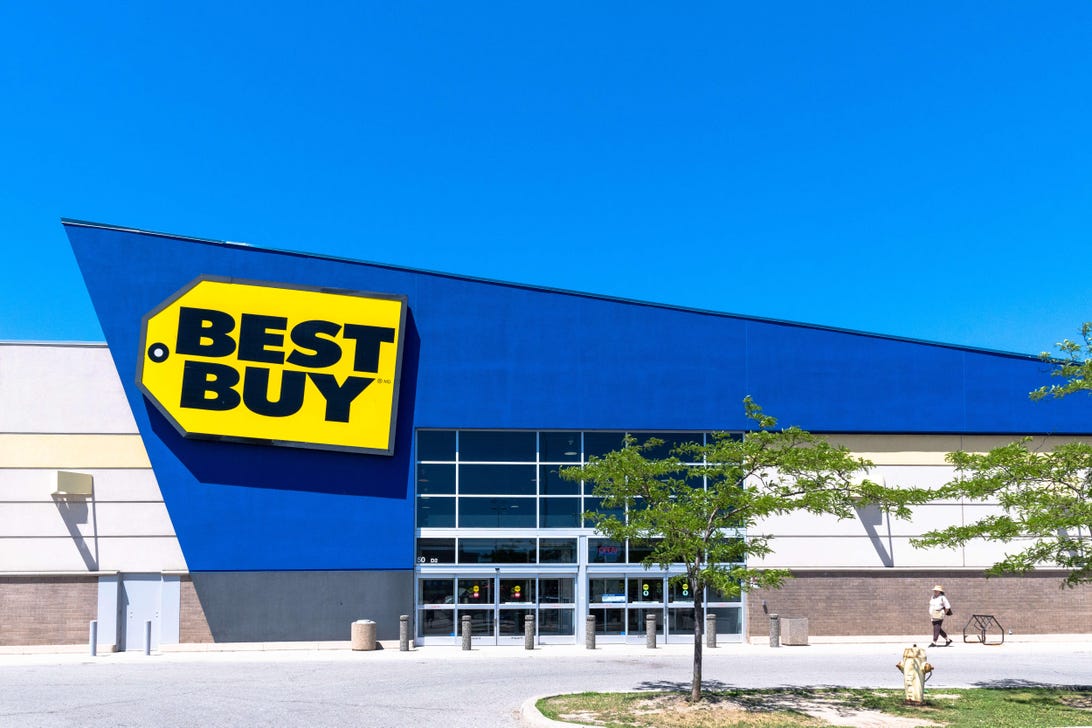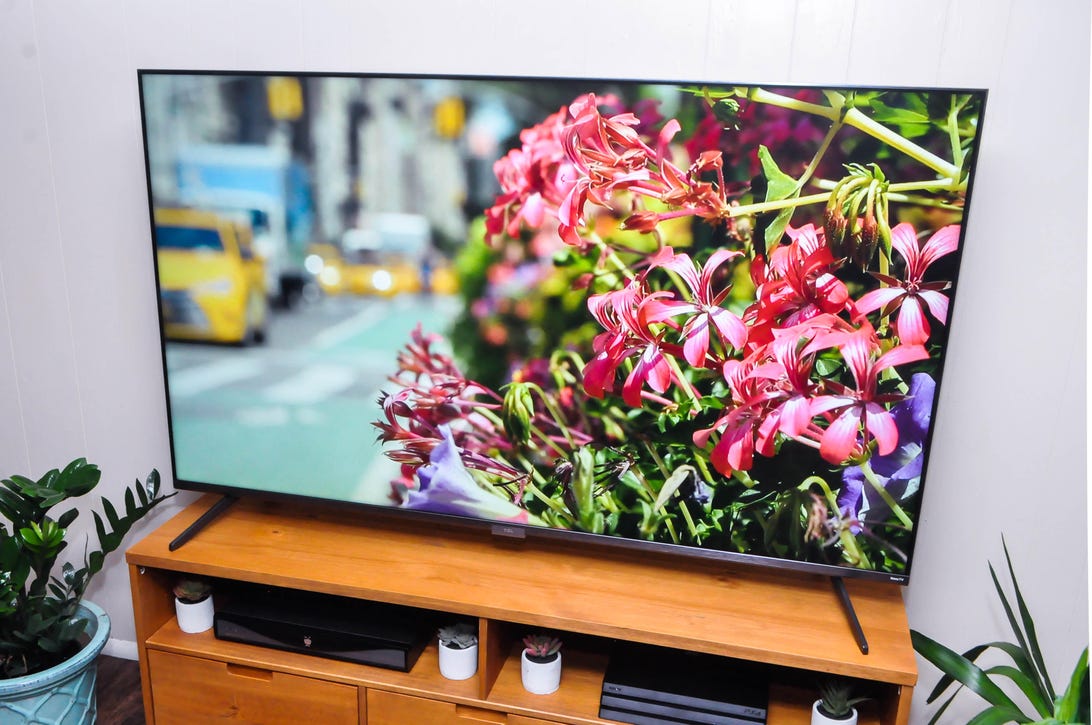Whether in-store or online, big or small, OLED or LCD — TV pricing follows an annual cycle.
Geoffrey Morrison/CNET
Like clockwork, the prices on televisions follow a regular annual cycle. Knowing when prices will fall could save you some money or at least some pricing anxiety. Here’s the cycle in a nutshell: CES, Super Bowl, spring shipments, minor summer price drops, fall/Black Friday/holiday major price drops.
New TVs are announced at CES in January. They’re not available then, however. There are often sales in the weeks leading up to the Super Bowl in February, but they’re on the previous year’s models. Current model year TVs start shipping in the spring, and that’s when they’re at their most expensive. There’s sometimes a slight price drop in the summer, but not always. During the fall and leading up to the holidays there are usually bigger price cuts. Black Friday and Cyber Monday often have the best deals, on both cheap doorbuster models as well as the best TVs, and those prices can often be had throughout December and the holidays. That brings us back to CES in January and the cycle begins anew.
So when is the best time to buy a new TV? It’s not as easy to say “when it’s cheapest” because that’s often when new models are right around the corner. Plus, the cheapest TV might not be the best value. Let’s dig a bit deeper.
Are you happy with what you have now?
Forget all the new tech. If your TV works and you’re happy with it, keep it. Don’t feel any pressure to upgrade.
Modern TVs are, on average, brighter and have better picture quality than the TVs from a few years ago. Unless you’re the type of videophile who wants to tweak every setting and fixates on nits and color accuracy, however, you probably don’t need a new TV.
Best TVs of CES 2021: Brighter OLED, Mini-LED QLED, 8K and HDMI 2.1
The pressure to upgrade is pervasive in our tech culture, but TVs tend to last longer, and be perfectly functional longer, than most devices. They don’t, for example, have batteries that lose capacity like mobile phones, or have wires that wear out like headphones. A TV from 5 or even 10 years ago likely works fine, though it might not look as good as the current 4K HDR TVs. So again, if that’s not a huge deal for you, you can likely keep what you have for a few more years.
This is even true when considering new consoles, the PlayStation 5 and Xbox Series X. If you’ve got a PS4, Xbox One or any console connected via HDMI, the new consoles should work fine. They might look better on a new TV, but they’ll still look great on yours.
Read more: Best TVs for PS5 and Xbox Series X, Series S
If your TV is having issues, or you just want something larger, that’s a different story. New TVs are much cheaper per inch than TVs of the past. You’ll be able to replace your current TV with something the same size, looks better and is cheaper than your old TV. Or you can pay the same amount as your old TV and get something that’s far bigger.
Sales
The biggest single days for TV sales are, of course, Black Friday and Cyber Monday. There are always some incredibly cheap 4K TVs on offer. But that’s not the whole story.
First of all, the TVs that get the biggest discounts are usually either no-name brands, or low-end models from name brands. They’re fine if you just want a cheap TV, but they’re not going to offer the picture quality of an even slightly higher-end model. The best TVs go on sale as well, but deep discounts on those are less common.

TC sales happen all year, but Black Friday season sees the biggest discounts.
Roberto Machado Noa/Getty Images
Second, massive discounts on TVs are rare in general. It might be counterintuitive, but TVs typically don’t have much mark-up. There isn’t a lot of profit in a $500 TV. So unless the store is trying to clear out stock, you shouldn’t expect a gigantic drop in price even during sales. Plenty of good discounts are available, they’re just not going to be “50% off” or similar, unless there’s a specific reason that model is getting such an extreme discount. Or it’s a doorbuster in limited quantities.
Third, most big companies don’t allow stores to offer their own pricing. This is called UPP, or Unilateral Pricing Policy. It means that a TV from that company is going to cost the same, whether it’s on Amazon, in Best Buy, or anywhere else. Well, anywhere else that wants to continue selling TVs from that company.

Most TV pricing is set by the manufacturer so it stays the same from store to store.
Sarah Tew/CNET
If this sounds sketchy, it is, but that’s a topic for a different article. The result is there’s usually no point in worrying if one store is going to have a sale. In most cases, either every store has a sale on that TV, or none do. Of course, that TV might go on sale (everywhere) next week. Some stores offer price protection in case this happens. Some credit cards do as well. Amazon, it’s worth noting, does not offer price protection.
What about next year’s TV tech?
To put it succinctly, there’s always something new around the corner. If this is your worry, it should give you peace of mind that even if something new hits the market next year, it’s going to be very expensive.
For example, MicroLED looks very promising, but you could buy a Porsche or two for the price of one MicroLED TV. It will be years before that’s mainstream tech.
Mini-LED, on the other hand, is available now. It’s a technology that promises close-to-OLED picture quality for less money. It’s likely we’ll see more brands with Mini-LED in the future.

On the left, the image as you’d see it on a mini-LED TV. On the right, an illustration of the mini-LED array on the back of the TV. With that many LEDs, the backlight has a greater “resolution,” so there can be finer distinctions between light and dark. The ideal, like OLED and microLED, would be per-pixel illumination, but mini-LED is a step closer to that without the cost of the other two technologies.
Geoffrey Morrison/CNET
Also rolling out across the country is NextGen TV, aka ATSC 3.0. This is free over-the-air 4K TV, and while it’s moving forward quite quickly and might already be available in your city. There are even some models with tuners built in that are available now. Don’t feel you need to rush to upgrade, or get those specific models, since worst case you’ll be able to buy a cheap external tuner and connect that to your TV.
There’s also HDMI 2.1. While 2.1 has several new technologies that are great, it’s not going to make any current TVs obsolete (unless it’s a current 8K TV, but that’s yet another story). As long as your current TV works with your current sources, you should be fine.
Really old TVs, older than 10 years, might have issues connecting to modern streaming and disc sources, but there’s no real workaround for that. If your TV doesn’t work with a new Roku or Blu-ray player, then you might need to upgrade if you want to use one of those.
So should you get a new TV?
Here’s the short version:
Get a new TV now if:
- Your current TV is having issues, or is too old to connect to a streaming service like Netflix.
- You’re willing to buy from a place that has a price-match policy, in case there’s a sale.
- You want something bigger than what you have now.
Don’t get a TV now if:
- Your current TV works fine.
- There’s literally anything else you need or want to spend money on.
If you’ve got the itch for something new, but you’re still on the fence, consider giving your TV a bit of a makeover. If you’ve never adjusted the settings, it’s easy to do and will probably make your TV look better than it ever has. That might tide you over for a bit.
And if you finally decide that, yes, you’re ready to buy a new TV now, we at CNET do have some guidelines and suggested 2021 models.
As well as covering TV and other display tech, Geoff Morrison does photo tours of cool museums and locations around the world, including nuclear submarines, massive aircraft carriers, medieval castles, airplane graveyards and more.
You can follow his exploits on Instagram, YouTube and on his travel blog, BaldNomad. He also wrote a bestselling sci-fi novel about city-sized submarines, along with a sequel.

Be the first to comment